FANTASTIC FOUR #51 - This Man, This Monster!
I bought this slightly beat up reader copy for $8!
One of the greatest FF saga's of all time it comes immediately following the Galactus Trilogy and just before the 1st appearance of the Black Panther! Man, Kirby was on a tear! I'll be honest... I'm NOT the biggest fan of Jack's covers. As great as he is at sequential story telling, action sequences, and even grand splash pages... I always thought his covers were primarily... functional.
But THIS, is one of my favorites. The cover says a LOT about what's inside... and it makes you wonder...
(FANTASTIC FOUR #51 cover-dated June 1966, on newsstands March 10th, 1966, with cover art by Jack Kirby with inks by Joe Sinnott)
THIS would've made a great cover too, except for the fact that the cover is already GREAT! But as far as splash pages go, this is also a great one and sets the tone immediately. The Thing is bummed out and depressed and wandering the streets...
(FANTASTIC FOUR #51 cover-dated June 1966, on newsstands March 10th, 1966, with art by Jack Kirby with inks by Joe Sinnott)
Stan used to make a big deal about the Marvel Method and how the artists would make even a simple telephone call look exciting and action packed. But the truth is, as far as Kirby, he knew exactly when to slow the pace down and show emotion. Kirby was a master of the art form...
(FANTASTIC FOUR #51 cover-dated June 1966, on newsstands March 10th, 1966, with art by Jack Kirby with inks by Joe Sinnott)
This issue was a month before Ditko quit and some wonder if Stan knew what was coming (or was already planning on replacing Ditko) and had John Romita do a warm-up for the character in Daredevil. Either way, Stan decided not to give us a glimpse in this ad!
(FANTASTIC FOUR #51 cover-dated June 1966, on newsstands March 10th, 1966, with art by... looks like Steve Ditko on the Spider-man and Wally Wood on the Daredevil)
Reed prepares to do what he has to and the 'fake' Ben Grimm realizes that maybe he was wrong. If Stan was modeling himself after Reed (and Jack, the Thing), it's kinda funny how he presents him as selfless and 'doing it without any fanfare'!
(FANTASTIC FOUR #51 cover-dated June 1966, on newsstands March 10th, 1966, with art by Jack Kirby with inks by Joe Sinnott)
As much as I have an issue with Stan's over-pontification and... what I think of as the 'dumbing down' of comic books, there are times when... his wording really DOES play a huge part in moving the story forward and adding to the drama. Here it's just perfect...
(FANTASTIC FOUR #51 cover-dated June 1966, on newsstands March 10th, 1966, with art by Jack Kirby with inks by Joe Sinnott)
The line may have snapped but the 'fake' Ben is so overwhelmed with guilt he jumps in to save Reed! And Reed's ready to take death like a man (with no thought of Sue)...
(FANTASTIC FOUR #51 cover-dated June 1966, on newsstands March 10th, 1966, with art by Jack Kirby with inks by Joe Sinnott)
And 'fake' Ben sacrifices himself to save Reed! What a sneaky way to have 'Ben' give his life to the guy who ruined HIS, without actually losing Ben...
(FANTASTIC FOUR #51 cover-dated June 1966, on newsstands March 10th, 1966, with art by Jack Kirby with inks by Joe Sinnott)
And now, a great essay on this issue by FF Historian Chris Tolworthy...
How Lee took credit for "This Man This Monster" by FF Historian Chris Tolworthy
I often hear people either praise or condemn Lee for the ending to "This Man This Monster" (Fantastic Four 51, FF51), where the red shirt dies. I am probably the world's most obsessive FF fan, and I want to argue that:
(1) FF51 is completely misunderstood. Yes, Lee had input, but NOT the way people think.
(2) Lee's reputation rests mostly on this book. This is due to the above misunderstanding.
PART 1: PLOT OVERVIEW
A quick refresher: FF51 is famous for two things: the red shirt death, and the first appearance of the Negative Zone, more accurately called the Sub-space portal. Thanks to Lee's edits, most readers miss the significance of the first plot, and so they miss the significance of the second.
This is the plot as most people see it:
Ben Grimm (The Thing) is depressed. An unnamed scientist takes advantage of this and steals Ben's power. He replaces Ben in the Fantastic Four, intending to kill Reed Richards. But he learns that Reed is really a hero, and sacrifices his own life to save Reed.
PART 2: WHY FF51 MATTERS
Some people love the "heroic death" ending. FF51 is sometimes voted "best comic of all time". It stands out even more as it comes right after the Galactus saga. It is seen as a change of gears, a different story. It is presented as proof that Lee and Kirby could turn on a dime and were masters of all topics.
--WHY IT IS CRITICISED--
Others find it less impressive. They point out that the unnamed scientist is a "red shirt": he is introduced simply to die. A cheap cliche.
--WHY IT MATTERS TO THE MARVEL METHOD--
It is often claimed (based on a superficial reading of Kirby's superhero art) that Kirby added the god-like cosmic elements to the Kirby-Lee stories, and therefore Lee added the human elements. When people learn more they are forced to back track: just look at Kirby's romance comics, or the personal depth in his Fourth World stories. And then look at the shallowness of Lee's writing. But here FF51 comes to the rescue.
FF51 is used as proof that Lee must have added the red shirt detail. After all, Kirby would never be so crass. And yet sales are sales. Survey after survey shows that people LOVE that story. So the narrative becomes, "Kirby aded the depth, Lee added the cliché. Both are essential. Neither man could do it alone. What a team!"
See for example the first volume of The Comics Journal Collected Library. The great question of "who did what?" is (supposedly) answered by the essay "Once And For All, Who Was The Author of Marvel?" (reprinted from The Comics Journal. October 1995: 70-78) The essay argues that Kirby did not do "noble death" stories but Lee loved them. Therefore (it argues) this is a sign of Lee's input.
FF51 thus becomes crucial to the pro Lee argument. We can PROVE that lee only dealt with shallow clichés. But the pro-Lee argument turns it round: this PROVES that Lee added the end to FF51. And since people LOVE that ending, it PROVES that Lee added a lot of the value! So now when any Lee fan begins to doubt, they remember FF51 and get a warm glow: their faith is secure.
I will next argue that the logic of that argument fails. And while Lee DID make major changes to that issue, they are not what we think.
PART 3: LEE WAS EDITOR, NOT PLOTTER
The idea that Lee added the ending is "special pleading": that is, all the evidence says Lee did NOT plot, but we say "in this one case he must have done (because the plot point is bad)". I will now remind readers why the default position must be why Lee did not plot this issue, and then show why the "bad ending" argument fails.
As we have shown time and again in the Marvel Method group, all the evidence points to Lee having MINIMAL control over the plot of the stories. He might say "Bring back Dr Doom" or "lighten up the tone" or "have them fight Spider-Man" but that's about it. Normally the story conferences take place behind closed doors, but when we do catch a glimpse they always show that lee had literally no idea what was in the comic until he saw it. This is nowhere more clear than around issue 51.
We are lucky to get two accidental glimpses into a story meeting around this time: one just before, one just after. For FF48, Roy Thomas accidentally walked in on a meeting and famously reported the "who's that guy?" quote. Lee knew nothing about the Silver Surfer until he saw him. Then for FF 55, Lee put on a fake meeting for a reporter, and Lee's comment shows he had no idea what was in the comic (being unaware of the ongoing Klaw plot, and thinking the Surfer whose whole story was being trapped on Earth, was "somewhere off in space"). So the default assumption must be that, barring other evidence, Lee did not plot the stories at all. He was an editor: he edited stories after they arrived.
PART 4: LEE'S MOST FAMOUS EDIT
The simplest way to see Lee's edits is to read the stories without dialogue. The "Kirby Without Words" blog shows that the art and dialogue are frequently in conflict.
The clearest and most common conflict is sexism (check the blog for examples). Lee always wanted the male hero to be THE MALE HERO. So:
* when a woman did something, Lee changed the dialogue to give credit to the man.
* When the male hero was controlled by a villain, Lee changed the dialogue so the male hero was NOT being controlled.
* When the male hero did something morally ambiguous (especially if it might offend the Comics Code) Lee changed the dialogue to make it safer.
The number one example is Reed Richards, Mr Fantastic. By editing out his moral conflicts, Lee removed the heart and soul of the Fantastic Four. I'll look at that next, and then how it changes FF51.
PART 5: EDITING OUT THE HEART OF THE FANTASTIC FOUR
Right from the start, Reed Richards made hard decisions that had bad consequences. In issue 1 he ignored his best friend: Ben Grimm warned him the space ship needed more shielding. Reed took the ship up anyway: Ben was right, the ship crashed, and Ben had his life ruined. Reed then took Ben's girl and always showed astounding insensitivity. Highlights are when he humiliated Ben in issue 13, and was unforgivably bad to him in issue 40, and so on and on, The pattern is usually that Reed has some Big Science invention, takes Big Risks, and Ben pays the high price.
Reed's story reflects real life: big science is amazing, but big science also has consequences. Lee undermined Reed's story by removing the conflict. Lee edited the dialogue to make Reed a one dimensional hero. So we lose the ongoing tragedy of how Reed hurts his best friend. And we therefore we lose the point of the Subspace portal in FF51.
PART 6: THIS MAN THIS MONSTER
Let's look back at the plot most people ignore. The fact that this is "the first appearance of the negative zone" is treated as a footnote, a coincidence. But when we remember the theme of Reed's life - scientist who hurts his friend - we recognise the pattern: Reed will do some Big Science and Ben will get hurt. Except this time Ben starts at the worst place ever. And this time it won't be Ben. This time Reed will finally see. This is the Big One where the "Reed hurts Ben" plot finally resolves.
In FF51 Reed decides that he has to build the ultimate weapon. The subspace portal lets him go anywhere, and therefore breach any walls, and obtain any technology. Such a portal makes nuclear weapons seem quaint and obsolete. Reed tries to keep it a secret from the team, and is angry when they find out about it. Here is the old theme again, taken to its final level: you just know that Ben will end up hurt. But this time there will be a twist. Instead of Ben paying the price, somebody will imitate Ben, thinking he has such a great life, and then THAT man will pay the price.
The idea of the scientist as both hero and monster is at least as old as Frankenstein. It was also the theme of the Hulk: "Is He Man Or Monster? Or Is He Both?" or it WAS the theme, until Lee's editing forced the Hulk to become a hero, again removing the heart from the story.
So "This Man This Monster" refers not just to Ben, not just to the unnamed scientist, but since issue one it has also referred to Reed. There are three men-monsters in this story, in different trajectories, so we can compare and contrast. The real monsters are often not the ugly people who see their faults clearly. The real monsters are the handsome people who are either unaware of their faults, or dismiss them for the greater goal. In the FF, Reed frequently hurts his best friend and is not even aware he is doing it. In this story, by seeing two other "monsters" lose everything (one is rejected by his best friend and loses his old life, the other who actually loses his life in Reed's latest experiment - it was Reed's faulty cable that broke), Reed finally learns to appreciate Ben: it is the climax of 51 issues.
Yet even here Kirby does not tell us what to think. We can still see the good in Reed, as the unnamed scientist does. Kirby is simply telling a tale of monsters: the monster that is IN ALL OF US. Ben, with his self destructive depression. Reed, with his blindness to the human cost of his actions. The unnamed scientist, with his readiness to tread on others to get "justice".
Lee's need to have one dimensional male heroes undermined this story. Just as it undermined the Hulk. Just as it undermined Spider-Man once Ditko left and Peter became handsome. It created shallow comics that only comic fans could love: comics that would never break into the mainstream of literature. And that is just the start.
PART 7: EDITING OUT THE HEART, CONTINUED
I discussed how Reed's science reflected the arms race. Did Reed NEED to beat the Russians into space at the expense of hurting his best friend? Did he NEED to ruins Ben's life to defeat Doctor Doom in issue 40? Did he NEED to build the ultimate weapon? That is left for the reader to decide. It was the story of the 1960s: the arms race. Did America need to build bigger and bigger bombs? Did it need to send people to die in Korea? Kirby shows both sides. These could be hard decisions that MUST be made for our survival. Or they could be mankind's greatest folly. Are the peaceniks the real heroes? Or just well meaning children? Both sides are there in Kirby's art, and he lets us decide.
Is there an alternative to this arms race? I mentioned how Lee added sexism: the men are always strong, the women weak. Strip that back to the original art, and we see a different story. Sue fights just as well as the boys: Sue beat Dr Doom the first time round, when the boys were helpless. But Sue's real power is in her alliances. Sue's compassion for Namor turned him from enemy to friend. Sue's compassion for the Impossible Man made him like humans. Sue's compassion for Triton turned the Inhumans from enemies to friends. And it was Alicia who really defeated Galactus, by getting inside the Surfer's heart: when Galactus lost his only friend he lost the will to fight. In each of these cases the women do not simply convert one person, but the convert a nation or a cosmic power. Kirby does not say "the women are right, the men are wrong", he simply shows both sides. But Lee's dialogue makes the women weak, so we remove the alternative to war, so the heart of the bigger story is lost.
Both sides of that lost story - the arms race and the power of love - change how we see the "noble sacrifice" of FF51.
PART 8: CONCLUSION: THE NOBLE SACRIFICE THAT WASN'T
Lee's editing always made Reed one dimensional. We therefore lose the central conflict of the story: the question of whether Reed should have done this, and whether the price was worth it: the price always paid by his friend. We still get a hint that this story is about Reed: the central tragedy on which the plot hinges is that Reed cannot even recognise his best friend. But most readers will not pick up on the importance of that, because Lee spent the past 50 issue telling everyone that Reed has no faults.
This time Kirby added a twist to the "Reed hurts Ben" story. A stranger thinks Ben has a great life so takes on his role. (The stranger only sees the outside.) And so the stranger pays the price. The arms race can hurt anyone, not just the people involved.
Without the central conflict - the question of whether Reed is man or monster - the reader looks round for another conflict. Is it with Ben? No, Ben is passive, and does not get what he wants, so he cannot be the protagonist. That leaves the unnamed scientist as the star. But as critics have pointed out, this is problematic. he is a red shirt: introduced just to die. We do not even know his name. And it is hard to sympathise, as most of the time he is a jerk and only makes the right decision at the end. But when we recover the central "is Reed Man or Monster" plot, the role of the scientist becomes clear.
The unnamed scientist does not make a noble sacrifice: he simply pays the price for his own crime of letting the rope break instead of saving Reed. His role is important, to show that inside people can be decent. But it is something ANYBODY should do. His role is to be an everyman: he struggles, he follows the tide of history, he has bad inside him, but also good. He is a human being, nothing more or less.
When we shift our attention to Reed, the ending now makes sense. Reed is pushing an arms race, at the expense of those around him (ignoring his wife, hurting his best friend). This lesser scientist is caught up in Reed's slipstream, envying him. So he gets the arms race bug, and he gets hurt instead of Ben. The message is not "noble sacrifice" but "the arms race hurts people." The story does not end with the man dying, it ends with Reed finally realising the importance of Sue and Ben.
THE REAL ENDING
Even if we choose to see the scientist as a hero in the end - and Kirby leaves us free to do so - it is simply a sub-plot, a tying up of a loose end, and not the point of the story. It is three pages before the end of the story. The story ends with Reed learning to value his best friend.
From this point on in the Fantastic Four, Reed never again hurts Ben. That is the whole point of the story. This is the real ending of the four part Galactus saga: to see that love is the answer. This issue is not a break from the Galactus story, it is the climax. It began in the previous issue, when Ben felt helpless knowing that the Surfer is here, a man he cannot defeat in any way, physically or for Alicia's love (he thinks). Note how Ben's depression simply mirrors Reed's despair when Galactus arrives. The saga is about feeling helpless. What can we do when we can do nothing? We can love.
Yet this ending is completely undermined because, according to Lee's editing, Reed never had any faults, he was never in despair, so had nothing to learn. So the reader is left turning back the pages looking for a satisfying ending, and the scientist is all we got.
SUMMARY
In summary, it seems to me that Kirby plotted the whole of FF51, just as he plotted everything else. And Lee edited the dialogue to make the hero one dimensional, just as he always did. This had the unexpected side effect of weakening the ending so much that people think Lee must have plotted it. Give the popularity of FF51, this becomes proof that Lee not just influenced plots, but added value. But there is no need for that hypothesis. FF51 is explained by Lee's normal editing.
At least, that's how I see it.


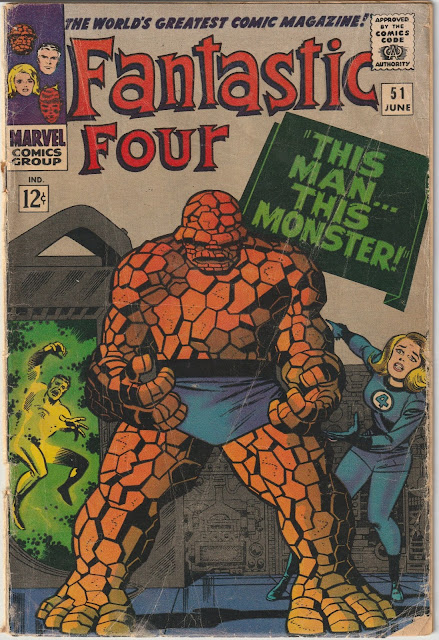
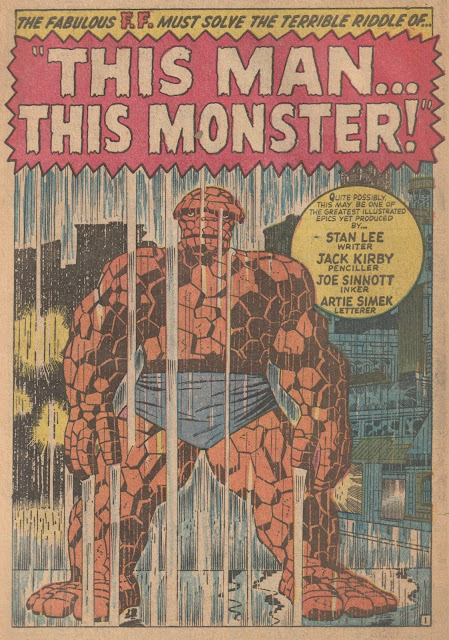
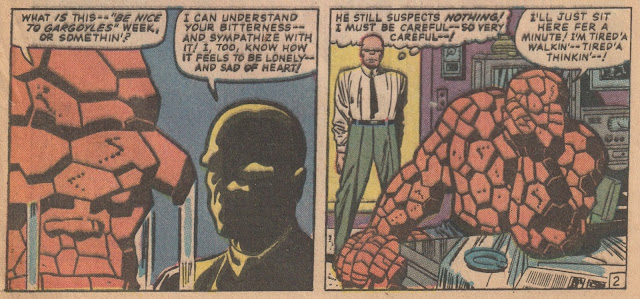
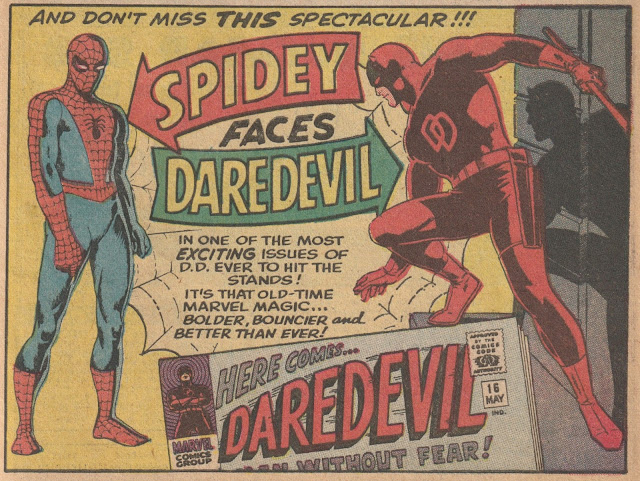
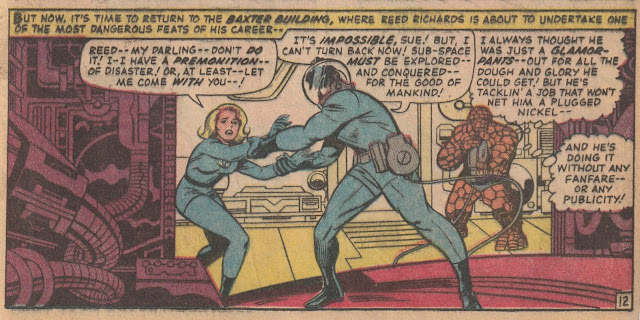

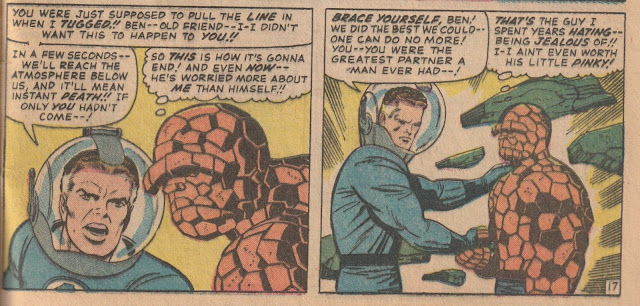
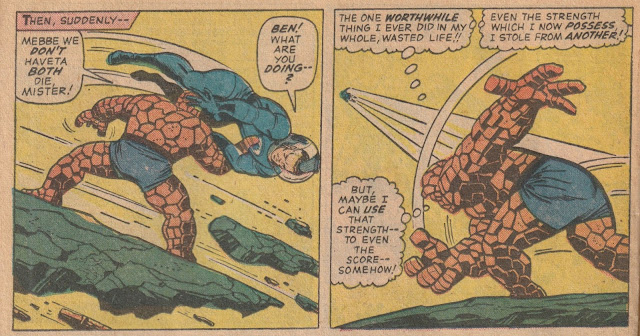

0 Comments
Recommended Comments
There are no comments to display.
Create an account or sign in to comment
You need to be a member in order to leave a comment
Create an account
Sign up for a new account in our community. It's easy!
Register a new accountSign in
Already have an account? Sign in here.
Sign In Now